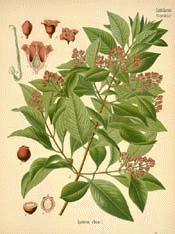

|
Sandalwood
(Santalum album LINN.)
|
Sandalwood
Botanical: Santalum album (LINN.)
Family: N.O. Santalaceae
---Synonym---Sanders-wood.
---Parts Used---Wood, oil.
---Habitat---India.
---Description---A small tree 20 to 30 feet high, with many opposite slender drooping branches, bark smooth grey-brown. Young twigs glabrous; leaves opposite, without stipules, petiole slender, about 1/2 inch long, blade 1 1/2 to 2 1/2 inches long, oval, ovate-oval or lanceolate, acute or obtuse at apex, tapering at base into petiole entire, smooth on both sides, glaucous beneath. Flowers small, numerous, shortly stalked in small pyramidal erect terminal and axillary, trichotomus paniculate, cymes panicle, branches smooth, bracts small passing into leaves below.
Perianth campanulate, smooth, about 1/5 inch long, divided into four (rarely five) triangular, acute, spreading segments, valvate, in bud rather fleshy, at first straw coloured, changing to deep reddish purple provided at the mouth with four erect, fleshy, rounded lobes. Stamens four, opposite, perianth segments, filaments short, in serted in mouth of perianth alternating witherect lobes. Anthers short, two-celled, introrse, ovary half, inferior, tapering, onecelled, an erect central placenta, rising from base and not reaching to the top, to the summit of which are attached three or four pendulous ovules without the usual coverings, style filiform, stigma small, three or four lobed on a level with anthers.
Fruit concealed about size of a pea, spherical, crowned by rim-like remains of perianth tube, smooth, rather fleshy, nearly black, seed solitary.
The trees are felled or dug up by roots; the branches are worthless, so are cut off. It is usual to leave the trunk on the ground for several months for the white ants to eat away the sap wood, which is also of no value; it is then trimmed and sawn into billets 2 to 2 1/2 feet long and taken to mills in the forests, where it is again trimmed and sorted into grades. It is heavy, hard, but splits easily; colour light yellow, transverse sections yellow to light reddish brown, with alternating light and dark concentric zones nearly equal in diameter, numerous pores, and traversed by many very narrow medullary rays. Odour characteristic, aromatic, persistent; taste peculiar, strongly aromatic. Indian Sandalwood is a Government monopoly.
[Top]
---Medicinal Action and Uses---Used internally in chronic bronchitis, a few drops on sugar giving relief; also in gonorrhoea and gleet; in chronic cystitis, with benzoic and boric acids. Much used as a perfume for different purposes. The wood is used for making fancy articles and is much carved.
Fluid extract, 1 to 2 drachms. Oil, 5 to 20 drops.
---Adulterants---Castor oil is often added, and on the Continent oil of cedar, made by distilling the chips remaining from the manufacture of lead pencils.
---Other Species---Pterocarpus santalinus or Santalum rubrum (Red Sandalwood), solely used for colouring and dyeing. Other varieties come from the Sandwich Islands, Western Australia and New Caledonia.
[Top]
Common Name Index
A MODERN HERBAL Home Page
Bear in mind "A Modern Herbal" was written with the conventional wisdom of the early 1900's. This should be taken into account as some of the information may now be considered inaccurate, or not in accordance with modern medicine.
© Copyright Protected 1995-2004 botanical.com

|

